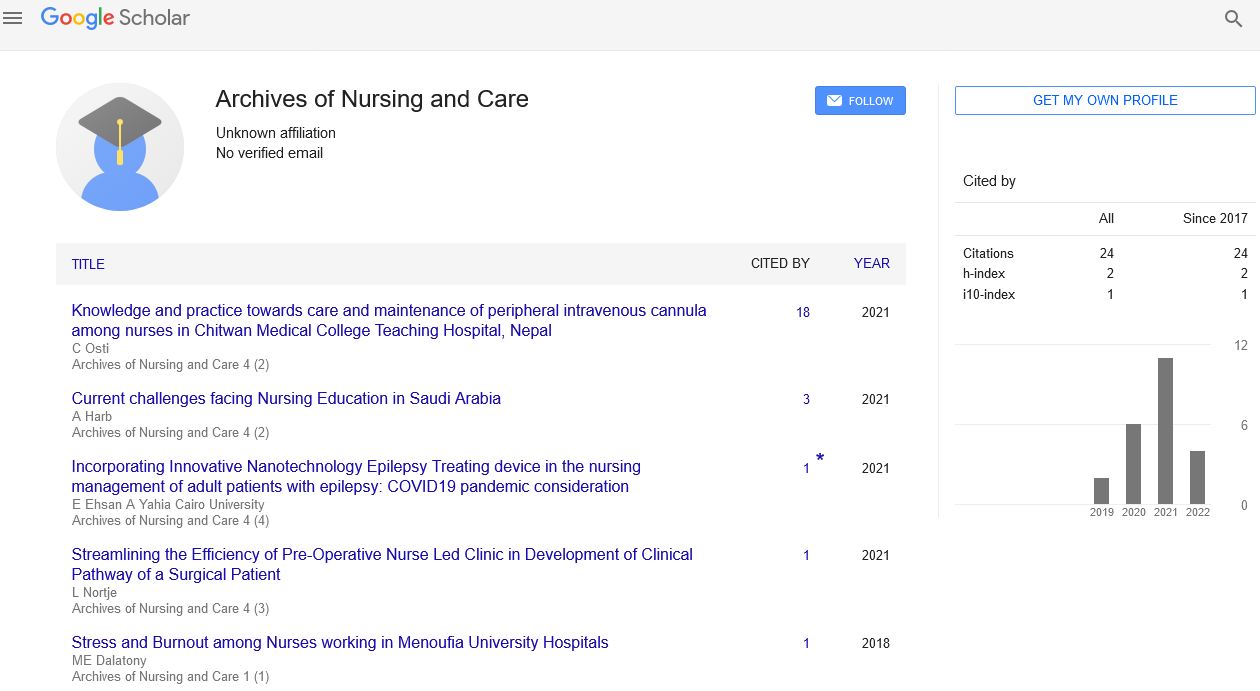Mini Review - Archives of Nursing and Care (2023) Volume 6, Issue 2
Paediatric orthopaedic nurses in hospitals
Jordan Gideon*
Southampton General Hospital, United Kingdom
Southampton General Hospital, United Kingdom
E-mail: gideonjordan@rediff.com
Received: 03-Apr-2023, Manuscript No. OANC-23-89191; Editor assigned: 05-Apr-2023, PreQC No. OANC-23- 89191 (PQ); Reviewed: 19-Apr-2023, QC No. OANC-23-89191; Revised: 24-Apr-2023, Manuscript No. OANC-23- 89191 (R); Published: 28-Apr-2023; DOI: 10.37532/oanc.2023.6(2).022- 024
Abstract
Due to a lack of formal education programmes that assist the growth of knowledge, paediatric orthopaedic nursing as a subspecialty of nursing has issues in Australia and the rest of the world. Despite these difficulties, it is nevertheless essential to guarantee the availability of skilled and knowledgeable nursing staff in order to improve the quality of healthcare outcomes. It is now necessary to create education programmes that are administered locally. Benner's "theory of novice to expert" has been used to design a multi-tiered paediatric orthopaedic nursing transition programme that combines work-based learning processes with formal assessment components in order to facilitate the development of experts in the clinical setting driven by the needs of specific clinical settings. The implementation of this programme has boosted nursing staff members' trust in the clinical context, which has improved the care provided to kids and their families in the orthopaedic department.
Keywords
competency • curriculum • education • expert • novice • orthopaedic • paediatric nursing • staff development • subspecialty • transition • work based learning
Introduction
Orthopaedic nursing involves helping and caring for people who suffer joint dislocation or bone fractures. A student pursuing this career will research a range of topics, such as pain management, joint injuries, and paediatric orthopaedic conditions. Registered nurses (RNs) with a focus on the skeletal and muscular systems are known as orthopaedic nurses, or simply "ortho nurses." They assist patients who have experienced broken bones, undergone orthopaedic surgery, or are managing long-term orthopaedic conditions by keeping track of patient progress, giving medications, helping with aids like crutches or canes, and scheduling physical and occupational therapy sessions to speed up recovery [1].
Depending on where they work, orthopaedic nurses may have a wide range of specialised responsibilities. Different duties apply to an orthopaedic nurse dealing with patients fresh from joint replacement surgery and an orthopaedic nurse working in an outpatient paediatric orthopaedic clinic. As opposed to instructing patients on how to use assistive equipment like crutches or how to put on an ankle support brace, like the nurse in the clinic may, the nurse in the hospital will probably spend more time giving IV pain drugs [2].
Orthopaedic nurses have the chance to assist patients who are in excruciating pain due to a range of illnesses in every setting. No two days are ever the same, according to orthopaedic nurse and Test Prep Insight contributor Alaina Ross. Orthopaedic nurses can operate in a range of environments with various schedules, patients, and responsibilities. Keep in mind that, according to the U.S. Bureau of Labor Statistics, hospitals employ the majority (60 percent) of registered nurses, with doctors' offices and outpatient care facilities coming in second. Let's go over some of the more specialised environments where orthopaedic nurses are employed [3].
Discussion
Centres for orthopaedic surgery
The process of bringing patients into, though, and recuperating from orthopaedic surgery depends heavily on nurses. They can work in preoperative, perioperative, and postoperative care (before, during, and after surgery). When a patient arrives at the hospital or surgery facility, preoperative care includes getting them ready for the procedure. This entails taking the patient's vital signs, looking over their medical record, cleaning the operating room, and starting fluids. Perioperative nurses might join a particular orthopaedic surgery team in the operating room (OR). They will set up the operating room (OR) in accordance with the surgeon's preferences and requirements, including specific information regarding equipment, tools, and supplies. In order to guarantee the patient's safety during surgery, they also work along with the anaesthetic team. They will frequently witness the same kind of procedure. Each patient, however, has particular demands and hazards [4].
Orthopaedic hospital unit
Following orthopaedic surgery, patients are typically sent to a hospital unit specifically for those with orthopaedic issues. On the ortho floor, nurses often take care of four to six patients at a time while working three 12-hour shifts per week. Giving painkillers, taking care of surgical drains, and changing dressings keep them very busy. They also collaborate with occupational and physical therapists to help patients regain their footing and resume their regular daily routines. These nurses have a significant impact on the patient's ability to walk after surgery.
In orthopaedic units, nurses are in charge of informing and releasing patients at the conclusion of their stay so they can go home or to a rehabilitation centre. In an orthopaedic unit, patients frequently come and go swiftly. They may be allowed to remain for just one night or for a maximum of three. The National Association of Orthopaedic Nurses' director, Amber Kujath, PhD, RN, ONC, recalled finishing several shifts on the orthopaedic unit with four patients who were different from the four she started with simply because they had all been released. It's crucial to be able to establish rapport with your patients right away, according to her [5].
Orthopaedic outpatient clinic
Orthopaedic clinics see patients for a number of conditions. Some may only have recently been hurt. Others might be seeking treatment for a condition like osteoporosis or getting ready for an orthopaedic surgery. The work of an orthopaedic nurse in a clinic is largely focused on instruction. They instruct patients on how to utilise crutches, canes, and braces, among other assistive devices. Additionally, they educate patients on what to anticipate following orthopaedic surgery. Splints, casts, slings, and wound dressings may also be applied by them. In a clinic setting, nurses frequently have multiple patient encounters. Developing enduring relationships with these individuals and assisting them as they get better over time can be rewarding [6-10].
Treatments provided by orthopaedist’s
Numerous musculoskeletal problems are treated by orthopaedic surgeons. These diseases can be inherited, the result of an injury, or the natural ageing process. Typical ailments that an orthopaedist may treat are:
• joint pain from arthritis
• bone fractures
• soft tissue injuries, which are those that affect muscles, tendons, and ligaments
• back pain
• neck pain
• shoulder pain and problems, such as bursitis
• carpal tunnel syndrome
• overuse and sports injuries, including sprains, tendinitis, meniscus tears, and anterior cruciate ligament (ACL) tears
• congenital conditions, such as clubfoot and scoliosis
• bone cancer
Conclusion
In order to adequately care for patients recovering from orthopaedic injuries and surgery, orthopaedic nurses have particular knowledge. These nurses are skilled professionals who have a love for assisting orthopaedic patients in getting back to their regular schedules. Major factors in safeguarding the surgeries we perform and the patients we perform them on include keeping the patient, wounds, and bandages clean and dry, applying and maintaining bandages correctly, managing pain effectively, encouraging appropriate and controlled activities, and fully educating and controlled activities, and fully educating the client.
References
- Wu SV, Tung HH, Liang SY et al. Differences in perceptions of self-care, health education barriers, and educational needs between diabetes patients and nurses. Contemp Nurse. 46, 187–196(2014).
- Sibbald RG, Ayello EA, Alavi A et al. Screening for the high-risk diabetic foot: A 60-second tool. Adv Skin Wound Care. 25, 465–476(2012).
- Miller JD, Carter E, Shih J et al. How to do a 3-min diabetic foot exam. J Fam Pract. 63, 646–656(2014).
- Kruse RL, LeMaster JW, Madsen RW. Fall and balance outcomes after an intervention to promote leg strength, balance, and walking in people with diabetic peripheral neuropathy: “Feet first” randomized controlled trial. Phys. Ther. 2010, 90, 1568–1579.
- Sumpio BE, Armstrong DG, Lavery LA et al. The role of interdisciplinary team approach in the management of the diabetic foot. J Vasc Surg. 51, 1504–1506(2010).
- Chin Y, Huang TT. Development and validation of a diabetes foot self-care behavior scale. J. Nurs. Res. 21, 19–24(2013).
- Gravely SS, Hensley BK, Hagood-Thompson C. Comparison of three types of diabetic foot ulcer education plans to determine patient recall of education. J. Vasc. Nurs. 29, 113–119(2011).
- Moss W, Darmstadt GL, Marsh DR et al. Research Priorities for the Reduction of Perinatal and Neonatal Morbidity and Mortality in Developing Country Communities. J Perinatol. 22:484-95(2002).
- Walsh JA, Measham AR, Feifer CN et al. The impact of maternal health improvement on perinatal survival: costeffective alternatives. Int J Health Plan Manage. 9, 131-49(1994).
- Zupan J. Perinatal mortality in developing countries. N Engl Med .352,2047- 8(2005)
Indexed at, Google Scholar, Crossref
Indexed at, Google Scholar, Cross ref
Indexed at, Google Scholar, Crossref
Indexed at, Google Scholar, Crossref
Indexed at, Google Scholar, Crossref
Indexed at, Google Scholar, Crossref
Indexed at, Google Scholar, Crossref
Indexed at, Google Scholar, Crossref

